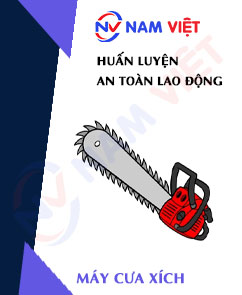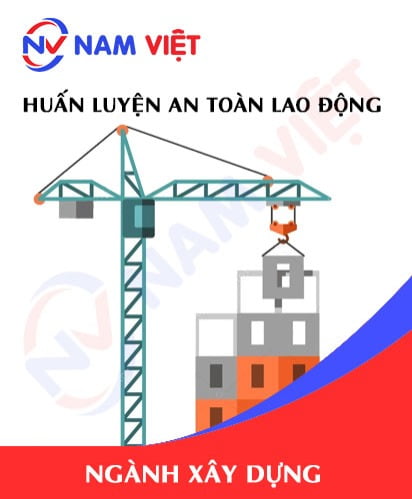Occupational Safety Training for Operating a Chainsaw
99,000 ₫
Note: The above price is calculated for one person and may vary depending on the number of trainees participating in the course and market fluctuations. For more accurate pricing support, please refer to the price list or contact our consultants directly.
Occupational safety is an important issue when operating a chainsaw and needs to be addressed promptly to ensure the health and safety of workers and enhance the reputation of businesses here. The Occupational Safety Training course is one of the effective solutions to raise awareness on preventing workplace accidents for workers when operating a chainsaw.
Table of Contents
Toggle1. Overview of the Chain Saw
a. What is a Chain Saw?
A chain saw is a tool or machine used to cut wood or other materials by using a fast-moving chain with sharp teeth running along a guide bar. Chain saws are commonly used in the wood industry, construction, and tree-trimming work. They can also be used in emergency situations, such as cutting trees after storms or natural disasters.
Chain saws are usually powered by gasoline or electric motors to drive the chain, enabling efficient cutting. The chain has sharp teeth and rotates at high speed, allowing it to cut through wood quickly and effectively. Chain saws require careful and safe operation, and users must follow specific safety rules to avoid accidents.

b. Operating principle of the chain saw
The operating principle of a chain saw is quite simple. It uses a sharp-toothed chain to cut through materials, mainly wood, through the rapid rotation of the chain. Here’s a basic overview of how it works:
- Motor: The chain saw is equipped with a motor, usually gasoline or electric, depending on the model. The motor provides the power to operate the saw.
- Chain: The chain is a series of connected links, each with sharp teeth designed to cut through material efficiently.
- Guide bar: The chain rotates around a long, narrow guide bar, often called the cutting bar or blade. The chain moves along the guide bar to perform the cutting action.
- High-speed rotation: The motor drives the chain to rotate continuously at high speed. When the chain contacts the material, the teeth cut through it.
- Material cutting: As the chain cuts through the material (e.g., wood), it creates a cut line. The user either moves the chain saw through the material or moves the material past the saw to complete the cut.
The chain saw cuts materials quickly and efficiently, but it also requires caution and skill from the user. Following safety rules is essential to prevent accidents.

c. Industries using chain saws
Chain saws are widely used across many industries due to their ability to cut materials quickly and effectively. Key industries include:
- Wood and forestry: Chain saws are commonly used for felling trees, cutting wood products, sawing boards, and wood processing.
- Construction: In construction, chain saws are used to cut wood and other building materials, such as timber, steel, and concrete.
- Transportation projects: For road construction and maintenance, chain saws are used to remove trees or other obstacles.
- Firefighting and rescue: Chain saws are also used in emergencies, such as clearing fallen trees after storms, landslides, or accidents to facilitate rescue operations.
- Forest work: In logging and forest management, chain saws are essential tools for cutting trees and timber.
- Personal use: Chain saws are also used for personal tasks, such as cutting trees in gardens or outdoor activities.
2. Overview of Safety Training for Operating Chain Saws
a. What is occupational safety training?
- Occupational safety training for operating chain saws equips workers with awareness and methods to prevent workplace accidents. Those who work directly with chain saws belong to Group 3.
- The training helps workers recognize and avoid hazards, reducing the risk of workplace accidents.
REGISTER FOR OCCUPATIONAL SAFETY TRAINING SERVICE
b. Training duration
Initial safety training duration:
- Total training time is at least 24 hours, including testing time.
- 8 hours of theory on safety policies and labor hygiene laws
- 8 hours of theory on basic occupational safety knowledge
- 4 hours of theory on specialized training content
- 2 hours of practical training on specialized content
- 2 hours of theoretical assessment at the end of the course
Training centers arrange sessions according to worker schedules. Typically, there are 6 sessions over 3 days if continuous learning is feasible.
Periodic safety training:
- Before the occupational safety card expires, workers must complete periodic safety training, lasting at least 50% of the initial training time.
Explanation: The total periodic training lasts at least 12 hours, including testing. Upon completion and passing the assessment, the worker’s safety card is renewed.
c. Training content
| No. | TRAINING CONTENT | TRAINING TIME (HOURS) | |||
| Total | Including | ||||
| Theory | Practical | Assessment | |||
| I | Policies and labor hygiene laws | 8 | 8 | 0 | 0 |
| 1 | Overview of legal documents on occupational safety and hygiene. | 6 | 6 | ||
| 2 | System of standards and technical regulations on safety and labor hygiene. | 1 | 1 | ||
| 3 | Specific regulations of state authorities regarding occupational safety during construction, expansion, or renovation of facilities and equipment requiring strict safety standards. | 1 | 1 | ||
| II | Basic knowledge of occupational safety | 8 | 8 | 0 | 0 |
| 1 | Basic knowledge of hazards and harmful factors at the workplace. | 4 | 4 | ||
| 2 | Methods to improve working conditions. | 1 | 1 | ||
| 3 | Safety culture in production and business. | 1 | 1 | ||
| 4 | Rights and obligations of employers and employees; policies on occupational safety; roles of safety officers. | 1 | 1 | ||
| 5 | Safety rules, signs, instructions, use of safety devices and PPE; first aid and occupational disease prevention skills. | 1 | 1 | ||
| III | Specialized training content | 6 | 4 | 2 | 0 |
| Comprehensive knowledge of machines, equipment, and hazardous substances; risk analysis and management; safe operating procedures. | 6 | 4 | 2 | ||
| IV | Final assessment | 2 | 2 | 0 | 0 |
| Total | 24 | 22 | 2 | ||
See more training content for all 6 groups
d. Occupational safety card
After completing the training and passing the assessment, workers will be issued an occupational safety card (commonly referred to as Group 3 safety certificate).
The Group 3 safety card displays full name, date of birth, job title, work environment, training duration, official stamp, and signature confirming completion.
According to Clause 2 of Article 24 of Decree 44/2016/ND-CP, there are 2 cases:
- If the employer and employee have a labor contract, the employer must sign, stamp, and validate the card after the employee completes the training and passes the assessment.
- If the worker is freelance or temporary with no labor contract, the training unit must sign, stamp, and validate the card after the worker completes the training and passes the assessment.

3. Hazards When Operating a Chainsaw
Operating a chainsaw can be very dangerous if basic safety rules are not followed and if you lack knowledge on how to use it. Here are some common hazards when operating a chainsaw:
- Injuries and accidents: Chainsaws can cause serious injuries or accidents if not handled carefully. Risks include cuts to hands, legs, or other body parts, falls, or injuries due to loss of control of the machine.
- Sharp cutting blade: The cutting blade and chain on a chainsaw are very sharp. If safety rules are not followed, direct contact with the blade can cause serious injuries.
- Explosion or fire: Chainsaws run on gasoline or diesel engines, so they have the potential to cause explosions or fires if not properly maintained and operated.
- Loss of control: Losing control of a chainsaw can lead to accidents. Particularly when cutting materials, the saw can jam or kick back, causing loss of control and the risk of falls or injuries.
- Toxic fumes: Chainsaws that run on gasoline or diesel emit fumes that can increase the risk of suffocation or health hazards if used in poorly ventilated or enclosed environments.

4. Measures to Control Workplace Accidents When Operating a Chainsaw
To control workplace accidents when operating a chainsaw, you should follow the following safety measures and rules:
- Training: Ensure that all chainsaw operators are trained in machine use and aware of safety rules. Training should include how to use the saw, safety rules, and emergency handling procedures.
- Use Personal Protective Equipment (PPE): Always wear PPE when operating a chainsaw. This includes safety glasses, helmet, cut-resistant gloves, cut-resistant clothing, and safety shoes. PPE helps protect against injuries and cuts.
- Chainsaw inspection: Before using the machine, inspect all parts of the chainsaw to ensure proper operation. This includes checking the cutting blade, chain, engine, oil and fuel systems, and other components.
- Work environment: Choose a safe working environment. Avoid hazardous conditions, such as fire-prone areas or poorly ventilated spaces.
- Follow basic safety rules: Follow basic safety rules such as not putting your hands near the blade while the machine is running, not using the chainsaw when tired or emotionally unwell, and always keeping the chainsaw stable.
- Use quality chainsaws from reputable stores to ensure machine stability and safety.
- Avoid working alone: Always work with others when using a chainsaw. If an incident occurs, others can help or call for emergency assistance.
- Fuel and oil management: Store and use fuel and oil for the chainsaw safely. Avoid exposure to flames or high temperatures.
- Emergency handling: Learn how to handle emergencies, such as a jammed chainsaw or accident. Know how to use fire extinguishers and how to call for help.
- Regular inspection of chainsaws to detect safety issues such as wear, damage, or mechanical failure, thereby reducing the risk of workplace accidents.
5. Benefits of Occupational Safety Training
An Toàn Nam Việt provides your business with the following benefits after completing occupational safety training courses in accordance with Decree 44/2016/ND-CP on Occupational Safety and Hygiene:
- Employees can recognize potential hazards in the workplace and take preventive measures to avoid accidents.
- Your business can establish risk prevention measures in production, operation, and maintenance processes.
- Reduce costs associated with workplace safety risks.
- Uninterrupted production helps increase labor productivity and product quality.
- Ensure compliance with labor safety laws and avoid legal risks.
- Create credibility and professionalism in all aspects, enhancing your brand image.
Nam Việt’s training courses are a solution to prevent external factors from causing harm to individuals, helping them avoid injuries or even fatalities.
REGISTER FOR OCCUPATIONAL SAFETY TRAINING
6. Customer Feedback After Completing Training
An Toàn Nam Việt has many years of experience accompanying businesses across Vietnam, particularly in the southern provinces. This responsibility is invaluable to Nam Việt, which is why our Occupational Safety Training is increasingly professional. Our growth is fueled by positive feedback and suggestions from our corporate partners. Below are some testimonials from clients we have served:
See more customer interviews after using services from An Toàn Nam Việt
7. An Toàn Nam Việt’s Occupational Safety Training Capabilities
An Toàn Nam Việt is a reputable and high-quality occupational safety training center in Vietnam, offering continuous training sessions at factories, production sites, and construction sites nationwide (all 63 provinces of Vietnam).
REGISTER FOR OCCUPATIONAL SAFETY TRAINING
Occupational Safety Training License
- An Toàn Nam Việt has been inspected and certified by the Safety Department of the Ministry of Labor – Invalids and Social Affairs as qualified to conduct occupational safety and hygiene training. This further strengthens our training capabilities.

Training Materials
- Before being used in occupational safety courses, training materials are reviewed to ensure accurate knowledge and practical effectiveness.
- Teaching methods of our instructors follow Nam Việt standards, developed by experts in occupational safety training to maximize knowledge absorption for learners.
Facilities
- Controlling classroom conditions enhances teaching efficiency and learners’ knowledge absorption.
- Our training facilities are spacious and meet standards for area, lighting, and training equipment.
8. Nationwide Reputable Occupational Safety Training Center
At An Toàn Nam Việt, we prioritize professional occupational safety training. Teaching workers to protect themselves equips them with safety knowledge essential for their livelihood and contributes to national development.
We carefully prepare every detail, from tools and teaching equipment to curriculum, documents, audio, and lighting, ensuring effective training.
Our instructors are experts with years of experience, some even conducting research on hazard identification across industries and prevention methods.
Lectures are practical, engaging, and easy to understand. Employees can learn comfortably while absorbing knowledge effectively. All content aligns with Decree 44/2016/ND-CP.
Employees learn how to prevent hazards and protect themselves, applying this knowledge practically.
Our training center is proud to provide professional, reputable occupational safety training with the following advantages:
- Competitive training costs with guaranteed quality.
- Flexible training schedule to match company production needs.
- Quick certification paperwork in compliance with law.
- Experienced instructors with many years in the field.
- Controlled classroom conditions to enhance teaching efficiency and knowledge retention.
- Course content tailored to occupational safety in businesses.
- Dedicated and professional support for clients quickly and accurately.

9. Additional Occupational Safety Training Materials
- Occupational Safety Training Material Set
- Safety Material for Chainsaw Operation
- Occupational Safety Training Test Set
- Multiple-choice Test for Chainsaw Safety
- Chainsaw Safety Training Slides
1 review for Occupational Safety Training for Operating a Chainsaw
No comments yet















phanminhhang341
Đơn vị chuyên nghiệp về huấn luyện an toàn lao động